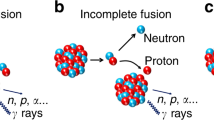Abstract
A hypothesis is presented for explaining the experimentally determined anomalous D/H ratio observed in the samples from the naturally occurring fission reaction in the Oklo phenomenon. No other explanation has been given, to our best knowledge, for the large difference between the measured D/H ratio in the Oklo samples and the expected values in a fission neutron spectrum. A multicomponent system consisting of hydrogen, deuterium, tritium and helium nuclei is considered. An analytical solution is derived and solved using as boundary conditions the experimentally determined value of the D/H ratio. The solution of the rate equations for hydrogen and deuteron concentrations, assuming a pure fission process without a deuteron sink term, yields a D/H ratio of 445 ppm for a reaction in which the fluence of neutrons is 1021 n/cm2. This exceeds the experimentally observed value of 127 ppm, and the naturally occurring value of 150 ppm. Solving the same rate equations accounting for a deuterium sink term using a hypothesis of deuteron disintegration, and the experimentally observed value of 127 ppm yields a deuteron disintegration constant of 7.47·10−14 s−1. Deutron disintegration would provide a neutron source, in addition to the fission neutrons, driving a subcritical chain reaction over an extended period of time. Relationship of the presented hypothesis to the Vlasov theory of an annihilation meteorite impact explosion explaining the experimentally observed anomalous235U/238U ratio, and to the suggestion of deuteron disintegration as a possible explanation of some observations of deuterium dissociation in palladium and titanium electrodes is discussed. The tritium and helium-3 rate equations are further solved under the deuteron disintegration hypothesis and the relationship of the present work to the work by JONES et al. is discussed.
Similar content being viewed by others
References
M. NEUILLY et al., Compt. Rend. Acad. Sci., 275 (1972) D-1847.
R. HAGEMANN et al., Le Phenomenon d'Oklo, Proc. IAEA Int Symp. Oklo Phenomenon, Libreville, Gabon, June 23–27, 1975, CONF-750461, International Atomic Energy Agency, 1975.
M. NEUILLY, R. NAUDET, Le Phenomenon d'Oklo, Proc. IAEA Int. Symp. Oklo Phenomenon, Libreville, Gabon, June 23–27, 1975, CONF-750461, International Atomic Energy Agency, 1975.
G. BAUDIN et al., Compt. Rend. Acad. Sci. 275 (1972) D-2291.
M. RAGHEB, G. MILEY, Fusion Technology, Vol. 9, No. 4, 1990.
M. RAGHEB and G. H. MILEY, Deuteron Disintregation in Condensed Media, J. Fusion Energy, n9 (1990) No. 4.
N. VLASOV, Soviet At. Energy, 34 (1973) 395.
S. JONES et al., Nature, 338 (1989) 737.
M. FLEISCHMAN, S. PONS, J. Electroanal. Chem., 261 (1989) 301.
Le Phenomenon d'Oklo, Proc. IAEA Int. Symp. Oklo Phenomenon, Libreville, Gabon, June 23–27, 1975, CONF-750461, International Atomic Energy Agency, 1975.
R. BODU et al., Compt. Rend. Acad. Sci., 275 (1972) D-1731.
Energie Nucleaire, 14 (1972) No. 5.
N. VLASOV, Soviet At. Energy, 34 (1973) 407.
Z. BILANOVIC, A. HARMS, Nuclear Sci. Eng., 91 (1985) 286.
P. KURODA, J. of Chem. Phys., 25 (1985) 781.
Chart of the Nuclides, 13th ed., General Electric, Co.
Author information
Authors and Affiliations
Rights and permissions
About this article
Cite this article
Shaheen, M., Ragheb, M. Anomalous deuteron to hydrogen ratio in naturally occurring fission reactions and the possibility of deuteron disintegration. Journal of Radioanalytical and Nuclear Chemistry, Articles 158, 323–342 (1992). https://doi.org/10.1007/BF02047119
Received:
Issue Date:
DOI: https://doi.org/10.1007/BF02047119




